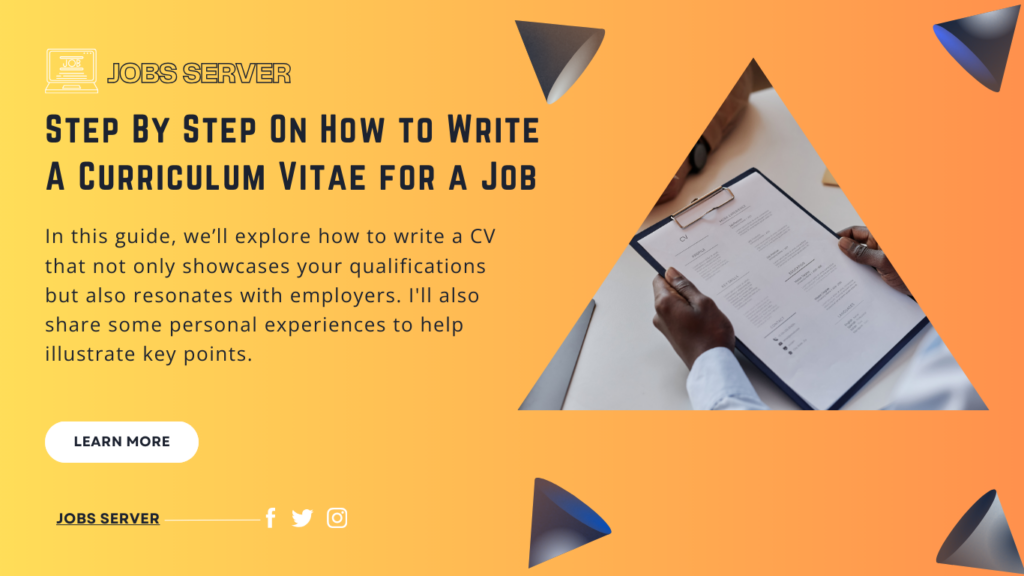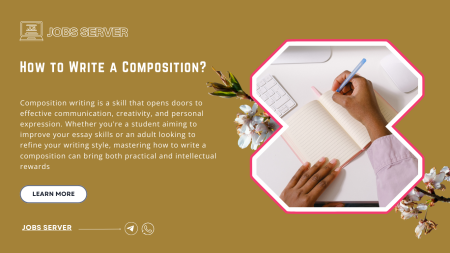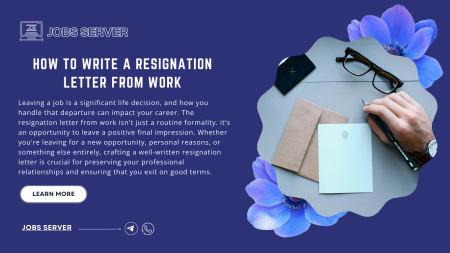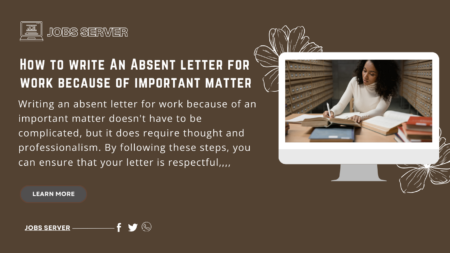Step By Step On How to Write A Curriculum Vitae for a Job
INTRODUCTION
Writing a CV that stands out in today’s competitive job market can be a frightening task, but it’s very important for getting the job you desire. As a job searcher, a well-written CV isn’t just a list of your qualifications and work experiences; it’s a personal marketing document that highlights your strengths, skills, and achievements. In this article, we will explore how to write a CV that not only showcases your qualifications but also resonates with employers. I’ll also share some personal experiences to help illustrate key points.
Understanding The Purpose Of A Curriculum Vitae
Before diving into the details of CV writing, it’s essential to understand what a CV is and why it’s so important. Your CV is often the first impression you make on a potential employer, and as they say, first impressions matter. It’s your opportunity to tell your story, to highlight what makes you the ideal candidate for the job. Unlike a resume, which is typically a one-page summary, a CV provides a more detailed account of your education, work experience, skills, and achievements.
When I applied for my first job after university, I spent weeks perfecting my CV. I wanted it to reflect not just my academic achievements but also the skills I had gained through internships, volunteer work, and personal projects. The time and effort I invested paid off, I was called in for an interview and eventually landed the job.
The Important Components of A Curriculum Vitae
To create a compelling Curriculum Vitae, it’s important to include several key sections. Each section should be tailored to the job you’re applying for, ensuring relevance and focus. Below are the essential components every CV should have:
- ALSO CHECK
- Step By Step On How To Write A Good Guarantor Letter
- Step By Step On How To Write Good Acknowledgment For A Project?
- Step By Step On How To Write Good Undertaking Letter To A Principal
- Step By Step On How To Write Good Application Letter For A Teaching Job In Primary School
1.. Contact Information Section:
-
- Name: Make sure your name is bold and easy to see at the top of the page.
- Phone Number: Use a phone number that you frequently check.
- Email Address: Use a professional email address (e.g., firstnamelastname@gmail.com). Avoid using nicknames or unprofessional email addresses that will make you unprofessional
- Social Media Profile {optional}: If you have an updated social profile, include the URL.
- Portfolio/Website: If you’re in a creative field, link to your portfolio or personal website.
2. Professional Section This is a brief, impactful section at the top of your CV that summarizes your experience, skills, and what you bring to the table. It should be tailored to the specific job you’re applying for or searching for. There was a time I was struggling with this section because I didn’t want to sound too generic. I took some time to reflect on my career achievements and what set me apart from other candidates. I ended up with a summary that highlighted my unique skills in content strategy, which resonated with employers. So, this section is very important
- Example Of Professional Section You Mighty Use: “Experienced digital marketer with over five years of expertise in SEO, content creation, and social media management. With a Proven track record in increasing online presence and driving customer engagement.”
3. Work Experience Section: This section is possibly the most important part of your CV. In here, you need to List your previous jobs in reverse consecutive order, starting with the most recent position. For each job, include the following:
-
- Job Title
- Company Name
- Location
- Dates of Employment
- Key Responsibilities and Achievements
NOTE: When detailing your responsibilities, focus on your achievements and the impact you had in each role. Use bullet points to make this section easy to read.
For Instance:
-
- I once Led a team of five in developing a new content strategy that increased organic traffic by 40%.
- I have also Managed social media campaigns that boosted follower engagement by 30%.

4. Education here, you list your educational background, including the names of institutions, degrees earned, and graduation dates. If you’re a recent graduate, you might want to place this section above your work experience.
For Instance:
-
- Master of Business Administration (MBA), University of Lagos, Nigeria, 2019
- Bachelor of Science in Computer Science, University of Nigeria, Nsukka, 2015
There was a time When I first graduated, I wasn’t sure how much emphasis to place on my education versus my work experience. After consulting with a career advisor, I realized that for roles requiring specific qualifications, it’s important to highlight relevant education at the top of the CV.
5. Skills Section: This section should be a well-curated list of skills related to the job you’re applying for. Avoid nonspecific skills and focus on those that match the job description.
For Example:
-
- SEO and SEM
- Data Analysis (Excel, SPSS)
- Project Management (Agile, Scrum)
- Content Creation and Copywriting
6. Certifications And Courses Section: If you have any relevant certifications or have completed courses that complement your professional profile, include them in this section. There was a time when I completed a course in project management, I included the certification on my CV. This addition helped me secure an interview for a project management role, as it demonstrated my commitment to continuous learning and skill development.
For Example:
-
- Google Analytics Certification, 2023
- Certified Scrum Master (CSM), 2022
- Digital Marketing Specialization, Coursera, 2021
7. Volunteer Experience Section: Including volunteer work can be particularly beneficial if you’re early in your career or if the experience is relevant to the job. It shows that you’re proactive and willing to contribute your time to worthwhile causes. They were a job search early in my career, I included my volunteer work with a local NGO where I managed their social media accounts. This experience was a talking point in interviews and helped me land a role in digital marketing.
For Example:
-
- Volunteer Content Writer, Habitat for Humanity, 2020 – Present
- I Was Worked As Community Outreach Coordinator, Lagos Food Bank Initiative, 2018 – 2020
8. Languages Section: This section is very important if you’re adept in more than one language, this section can be a significant advantage, especially for roles in multinational companies or customer-facing positions.
Example:
-
- English (Fluent)
- French (Intermediate)
- Igbo (Native)
- Hausa
- Yoruba
- I can remember when I once applied for a customer service role where bilingual candidates were preferred. My proficiency in French helped me stand out and ultimately secure the job.
9. Hobbies and Interests Section: While this section isn’t mandatory, it can give employers insight into your personality and how well you might fit into the company culture. However, only include hobbies that are genuine and could be relevant to the role. When I applied for a role in content writing, I included my interest in blogging. This sparked a conversation during the interview, where I was able to showcase my passion for writing and content creation beyond my professional experience.
For Example:
-
- I love Blogging about technology trends
- I sometime Participate in local hackathons
- I also love reading business and self-development books
Modifying And Customization Of Your CV For The Job
One of the most critical aspects of CV writing is customization. Sending the same CV to every job application is a common mistake that can reduce your chances of getting noticed. Modifying your CV involves modifying your professional summary, work experience, and skills to align with the specific job description. I remember applying for two different roles at the same company one in digital marketing and the other in content strategy. I created two versions of my CV, each highlighting the skills and experiences most relevant to the respective roles. As a result, I was called in for interviews for both positions.
Formatting And Designing Instructions For Your CV
While the content of your CV is the most important aspect, the format and design can significantly impact how your CV is perceived. Early in my career, I used a CV template with too many colors and fonts, thinking it would make my application stand out. However, I soon realized that it made my CV look unprofessional. I switched to a simpler design, and the feedback I received improved significantly.
Here are some tips:
- Learn How To Keep It Simple: Avoid overly complex designs. A clean, easy-to-read layout is more effective.
- Learn How To Use Bullet Points: Bullet points make your CV more readable and allow employers to quickly scan for key information.
- Learn How To Use Good Font: Use professional, easy-to-read fonts like Arial, Calibri, or Times New Roman.
- Learn How To Be Consistency: Ensure that the formatting is consistent throughout your CV, including font size, bullet points, and spacing.
Common Mistakes To Avoid When Writing CV
- Spelling And Grammar Errors: Nothing turns off an employer faster than a CV riddled with errors. Always correct your CV multiple times and consider using tools like Grammarly. I once missed out on a job opportunity because of a simple typo in the company’s name. It was a harsh lesson that taught me the importance of attention to detail.
- Being Too Vague: Avoid plain statements that don’t provide concrete examples of your skills or achievements.
SOME ASKED QUESTIONS ON STEP BY STEP ON HOW TO WRITE A CURRICULUM VITAE FOR A JOB
- What should I include in a CV for a job?
Include your contact details, a professional summary, work experience, education, skills, and any certifications or courses. Tailor each section to the job you’re applying for to make it relevant and impactful. - How long should a CV be?
A CV should typically be two pages. However, for entry-level roles or early-career candidates, one page can be enough. Focus on quality over quantity. - Should I include hobbies and interests on my CV?
Yes, but only if they are relevant to the job or reflect skills the employer might value. Hobbies can show your personality and help you stand out. - How do I write a CV with no work experience?
Highlight your education, skills, volunteer work, internships, and any relevant projects. Focus on transferable skills, like communication or problem-solving. - What format is best for a CV?
Use a clean, simple format with professional fonts like Arial or Calibri. Organize sections clearly, using bullet points for readability. - Should I include a photo on my CV?
In most countries, it’s not necessary to include a photo unless the job specifically requires it, such as in modeling or acting. - How do I tailor my CV to a specific job?
Read the job description carefully, then adjust your professional summary, work experience, and skills to match the employer’s needs. Use similar keywords to increase relevance. - How do I write a professional summary for a CV?
Summarize your experience, skills, and what you bring to the table in two or three sentences. Be concise and direct, emphasizing what makes you unique. - What’s the difference between a CV and a resume?
A CV is usually longer and provides a detailed account of your career and education. A resume is shorter, typically one page, and focuses on recent and relevant experiences. - Can I use a CV template?
Yes, templates can help with formatting, but customize the content to reflect your personal experiences and qualifications. Avoid using overly common templates that don’t stand out. - How do I write achievements in a CV?
Use bullet points to highlight specific achievements. Quantify them if possible, like “Increased sales by 20%” or “Managed a team of 5.” - How often should I update my CV?
Update your CV every time you gain new skills, complete a project, or change jobs. Keeping it fresh ensures you’re always prepared for opportunities. - What skills should I put on a CV?
List skills relevant to the job you’re applying for. These could include technical skills, like programming, or soft skills, like leadership or teamwork. - Should I list all my work experience on my CV?
No, focus on the most recent and relevant jobs. If you have extensive experience, prioritize roles that align with the position you’re applying for. - How do I make my CV stand out?
Customize it for each job, focus on your achievements, and keep the design simple but professional. Tailoring your CV shows attention to detail and effort. - What font size should a CV be?
Use a font size between 10 and 12 points for the body text. Your name and section headers can be slightly larger for clarity and emphasis. - How do I list certifications on my CV?
Include a separate section for certifications. List the certification name, issuing organization, and the date you received it. - How important is the education section on a CV?
Education is crucial, especially for entry-level roles. If you have work experience, place the education section below your experience. - Should I include references on my CV?
It’s not necessary to include references unless the job posting asks for them. You can simply write, “References available upon request.” - How do I format work experience on my CV?
List your job title, the company name, location, and dates of employment. Under each job, provide bullet points of your key responsibilities and achievements.





